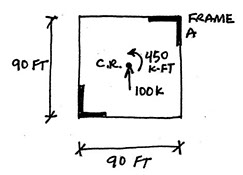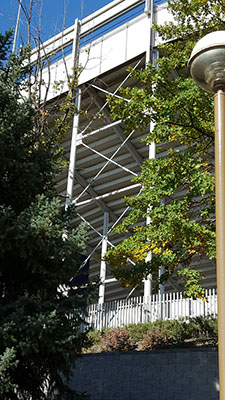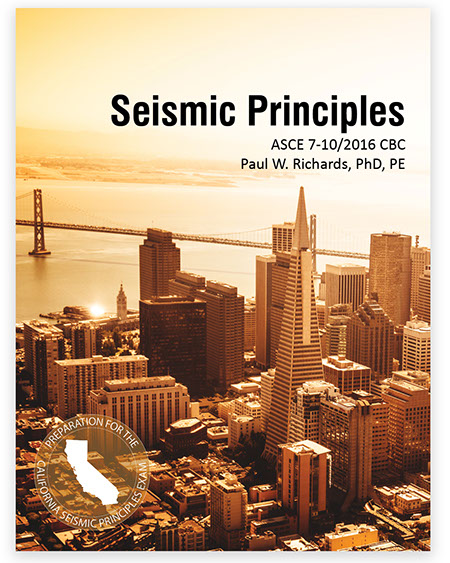Seismic Principles
31. What is the Risk Category for a 20-story condominium building with a maximum occupancy of 1000 people?
(a) I
(b) II
(c) III
(d) IV
Solution
Best answer: (b)
Explanation
Table 1604.5 in the CBC is the source document for determining Risk Categories. Most residential buildings are Risk Category II.
Risk Categories are explained in Section 3.7 (and Table 3.4) of Seismic Principles. The great thing about Seismic Principles is that an explanation of each concept is provided on the same page as the pertinent tables and accompanying examples. This organization facilitates quick look-up during the exam. Get your copy.
32. A building is 100 ft by 60 ft in plan. The flat roof snow load is 25 psf. How much snow weight should be included in the seismic weight?
(a) 0 kips
(b) 25 kips
(c) 30 kips
(d) 150 kips
Solution
Best answer: (a)
Explanation
Snow weight is only included in the seismic weight if it is greater than 30 psf [see ASCE 7-10 12.7.2]. See Section 3.14 and Example 3.28 in Seismic Principles.
33. What makes a seismic force-resisting system "special"?
(a) Extra strength
(b) Extra stiffness
(c) Extra ductility
(d) Both (a) and (c)
Solution
Best answer: (c)
Explanation
"Special" systems are introduced in Section 1.5 of Seismic Principles. The entire first chapter of Seismic Principles is available for preview and provides a great foundation for understanding seismic design concepts.
34. A 3-story building, with a period of 0.2 seconds, has a roof weight that is half of the floor weights. The story heights are all equal.
What is Cvx for the roof level?
(a) 0.25
(b) 0.33
(c) 0.50
(d) 0.67
Solution
Best answer: (b)
Hints
A distribution table is the easiest way to do this calculation. See Section 3.16 and Example 3.30 in Seismic Principles for an explanation of how to set up the distribution table. Get your copy.
35. For the plan below all frames have the same stiffness.

What is the force in Frame A if the diaphragm is rigid?
(a) 40.7 kips
(b) 42.2 kips
(c) 52.5 kips
(d) 75.3 kips
Solution
Best answer: (c)
Hints
Rigid diaphragm analysis is explained in Chapter 5 of Seismic Principles, with examples provided. You will not find an explanation of rigid diaphragm analysis in any of the source documents (ASCE 7 or the CBC). In order to be prepared for the test you will need to have the equations written, preferably with some examples alongside. Get your copy.
36. What is the response modification coefficient for steel storage racks?
(a) 1.5
(b) 4
(c) 6
(d) 8
Solution
Best answer: (b)
Explanation
Steel storage racks are nonbuilding structures. The response modification factor for nonbuilding structures can be looked up in Table 15.4-1 in ASCE 7.
Chapter 12 of Seismic Principles gives a thorough explanation of nonbuilding structures including several examples and a table with the same information as Table 15.4-1. Get your copy.
37. A special moment frame in an office building experiences the displacements shown below when subjected to the equivalent lateral force. All stories are 14 ft tall.

(a) The frame has adequate stiffness
(b) The frame needs increased stiffness
(c) The frame needs increased strength
(d) Both (b) and (c)
Solution
Best answer: (b)
Hints
There are four steps to this problem. First, the inelastic displacements need to be estimated (see Section 6.12 of Seismic Principles, Examples 6.17-6.18). Second, the inelastic drifts need to be calculated. Third, the drift limit needs to be calculated (see Section 6.11 of Seismic Principles, Examples 6.14-6.16). Finally, the calculated inelastic drifts need to be compared with the drift limits.
Examples 6.17 and 6.18 of Seismic Principles demonstrates all of these steps. Get your copy.
38. The picture below shows a braced frame from a football stadium built in 1982. The braced frame is 60 ft tall. The site has: SDS=0.9g.

If this stadium were being built today at the same site, could the same type of bracing be used?
(a) Yes, if R=6 is used during design
(b) Yes, if R=3.25 is used during design
(c) No
(d) More information is required
Solution
Best answer: (c)
Explanation
A variety of knowledge is required to correctly answer this question. The stadium will be in Risk Category III, and since SDS is large, it will be in Seismic Design Category D. If built today, this stadium would require a high ductility braced frame system. The bracing shown is called tension-only bracing, because the braces are very slender and have negligible compression capacity. Tension-only bracing cannot be used in high-ductility braced frames.
Studying Seismic Principles will give you the knowledge you need to solve complicated questions like this. Section 3.7 of Seismic Principles explains Risk Categories. Section 3.8 of Seismic Principles explains Seismic Design Categories. Section 3.9 of Seismic Principles explains the restriction on various systems based on Seismic Design Category. And Section 10.3 of Seismic Principles explains the specific requirements for various steel systems. Get your copy.
39. Which of the following is not true about site parameters for particular sites?
(a) SDS=(2/3)SMS
(b) SDS could be greater than SS
(c) SDS is always greater than SD1
(d) SM1=FaS1
Solution
Best answer: (d)
Explanation
The equations for SDS and SM1 are found in Section 1613 of the CBC. Answer (d) is not true because SM1=FvS1. Choice (b) is tempting, but is true when Fa is greater than 1.5.
40. A chimney extends 4 ft above the roof of a house. There is no bracing, so it is considered a cantilever chimney. The portion of the chimney above the roof weighs 400 lbs. The site has SDS=0.9g.
What is the seismic design force for the chimney?
(a) 58 lbs
(b) 173 lbs
(c) 405 lbs
(d) 432 lbs
Solution
Best answer: (d)
Hints
A chimney is a nonstructural component and Chapter 13 of ASCE 7 addresses such elements. Section 11.5 of Seismic Principles summarizes the equations for nonstructural components and provides a completely work example. Get your copy.
